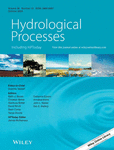Development of pan coefficients for estimating evapotranspiration from riparian woody vegetation
Doody, Tanya M , Benyon, Richard G , Theiveyanathan, S , Koul, Vijay , Stewart, Leroy
2014-02-15 null null 28(卷), null(期), (null页)
The long-term Millennium Drought' has put significant pressure on water resources across Australia. In southeastern Australia and in particular the Murray-Darling Basin, removal of exotic, high-water-use Salix trees may provide a means to return water to the environment. This paper describes a simple model to estimate evapotranspiration of two introduced Salix species under non-water-limited conditions across seven biogeoclimatic zones in Australia. In this study, Salix evapotranspiration was calculated using the Penman-Monteith model. Field measurements of leaf area index and stomatal conductance for Salix babylonica and Salix fragilis were used to parameterize the models. Each model was validated using extensive field estimates of evapotranspiration from a semi-arid (S.babylonica, r(2)=0.88) and cool temperate (S.fragilis, r(2)=0.99) region. Modelled mean annual evapotranspiration showed strong agreement with field measurements, being within 32 and 2mmyear(-1) for S.babylonica and S.fragilis, respectively. Monthly pan coefficients (the ratio of mean evapotranspiration to mean pan evaporation) were developed from 30years of meteorological data, for 30 key reference sites across Australia for both species using the validated Penman-Monteith models. Open-water evaporation was estimated from field measurements and was used to develop a simple linear regression model for open-water evaporation across the 30 reference sites. Differences between modelled evapotranspiration and open-water evaporation at each site provide an indication of the amount of water that might be returned to the environment from removal of in-stream Salix species. The monthly pan coefficient method reported has application across riparian environments worldwide where measured evapotranspiration is available for model validation. Copyright (c) 2013 John Wiley & Sons, Ltd.
相关推荐
- A river basin spatial model to quantitively advance understanding of riverine tree response dynamics to water availability and hydrological management [2014-02-15]
- Fine scale mapping of fractional tree canopy cover to support river basin management [2014-02-15]
- Wide-area estimates of evapotranspiration by red gum (Eucalyptus camaldulensis) and associated vegetation in the Murray-Darling River Basin, Australia [2014-02-15]



